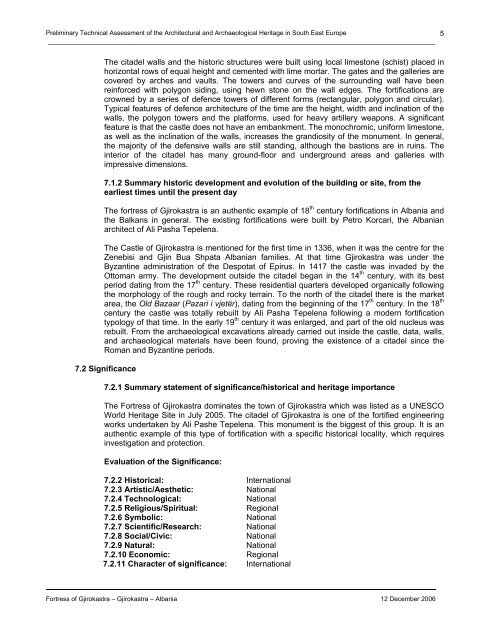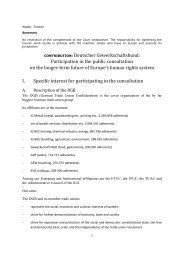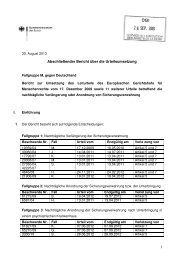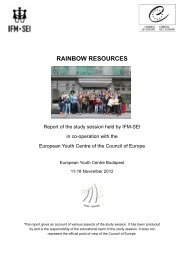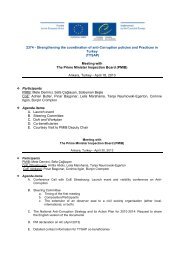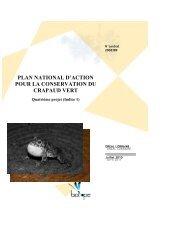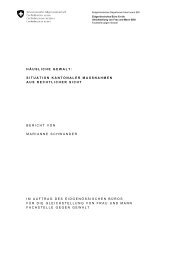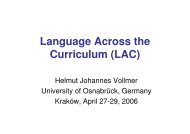FORTRESS OF GJIROKASTRA Gjirokastra Albania
FORTRESS OF GJIROKASTRA Gjirokastra Albania
FORTRESS OF GJIROKASTRA Gjirokastra Albania
Create successful ePaper yourself
Turn your PDF publications into a flip-book with our unique Google optimized e-Paper software.
Preliminary Technical Assessment of the Architectural and Archaeological Heritage in South East Europe<br />
________________________________________________________________________________________________<br />
The citadel walls and the historic structures were built using local limestone (schist) placed in<br />
horizontal rows of equal height and cemented with lime mortar. The gates and the galleries are<br />
covered by arches and vaults. The towers and curves of the surrounding wall have been<br />
reinforced with polygon siding, using hewn stone on the wall edges. The fortifications are<br />
crowned by a series of defence towers of different forms (rectangular, polygon and circular).<br />
Typical features of defence architecture of the time are the height, width and inclination of the<br />
walls, the polygon towers and the platforms, used for heavy artillery weapons. A significant<br />
feature is that the castle does not have an embankment. The monochromic, uniform limestone,<br />
as well as the inclination of the walls, increases the grandiosity of the monument. In general,<br />
the majority of the defensive walls are still standing, although the bastions are in ruins. The<br />
interior of the citadel has many ground-floor and underground areas and galleries with<br />
impressive dimensions.<br />
7.1.2 Summary historic development and evolution of the building or site, from the<br />
earliest times until the present day<br />
The fortress of <strong>Gjirokastra</strong> is an authentic example of 18 th century fortifications in <strong>Albania</strong> and<br />
the Balkans in general. The existing fortifications were built by Petro Korcari, the <strong>Albania</strong>n<br />
architect of Ali Pasha Tepelena.<br />
The Castle of <strong>Gjirokastra</strong> is mentioned for the first time in 1336, when it was the centre for the<br />
Zenebisi and Gjin Bua Shpata <strong>Albania</strong>n families. At that time <strong>Gjirokastra</strong> was under the<br />
Byzantine administration of the Despotat of Epirus. In 1417 the castle was invaded by the<br />
Ottoman army. The development outside the citadel began in the 14 th century, with its best<br />
period dating from the 17 th century. These residential quarters developed organically following<br />
the morphology of the rough and rocky terrain. To the north of the citadel there is the market<br />
area, the Old Bazaar ( Pazari i vjetër ), dating from the beginning of the 17 th century. In the 18 th<br />
century the castle was totally rebuilt by Ali Pasha Tepelena following a modern fortification<br />
typology of that time. In the early 19 th century it was enlarged, and part of the old nucleus was<br />
rebuilt. From the archaeological excavations already carried out inside the castle, data, walls,<br />
and archaeological materials have been found, proving the existence of a citadel since the<br />
Roman and Byzantine periods.<br />
7.2 Significance<br />
7.2.1 Summary statement of significance/historical and heritage importance<br />
The Fortress of <strong>Gjirokastra</strong> dominates the town of <strong>Gjirokastra</strong> which was listed as a UNESCO<br />
World Heritage Site in July 2005. The citadel of <strong>Gjirokastra</strong> is one of the fortified engineering<br />
works undertaken by Ali Pashe Tepelena. This monument is the biggest of this group. It is an<br />
authentic example of this type of fortification with a specific historical locality, which requires<br />
investigation and protection.<br />
Evaluation of the Significance:<br />
7.2.2 Historical: International<br />
7.2.3 Artistic/Aesthetic: National<br />
7.2.4 Technological: National<br />
7.2.5 Religious/Spiritual: Regional<br />
7.2.6 Symbolic: National<br />
7.2.7 Scientific/Research: National<br />
7.2.8 Social/Civic: National<br />
7.2.9 Natural: National<br />
7.2.10 Economic: Regional<br />
7.2.11 Character of significance: International<br />
________________________________________________________<br />
Fortress of <strong>Gjirokastra</strong> –<strong>Gjirokastra</strong> –<strong>Albania</strong> 12 December 2006<br />
5


